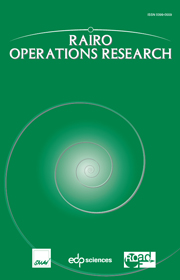Article contents
A variational model for equilibrium problems in a traffic network
Published online by Cambridge University Press: 15 April 2004
Abstract
We propose a variational model for one of the most importantproblems in traffic networks, namely, the network equilibrium flow that is, traditionallyin the context of operations research, characterized by minimum cost flow. This model has the peculiarity of being formulated by means of a suitable variational inequality (VI) andits solution is called “equilibrium”. This model becomes a minimum cost model when the cost function is separableor, more general, when the Jacobian of the cost operator is symmetric;in such cases a functional representing the total network utility exists.In fact in these cases we can write the first order optimality conditions which turn out to be a VI.In the other situations (i.e., when global utility functional does not exist),which occur much more often in the real problems, we can study the network by looking for equilibrium solutions instead of minimum points.The Lagrangean approach to the study of the VI allows us to introduce dual variables, associated to the constraints of the feasible set, which may receive interesting interpretations in terms of potentials associated to the arcs and the nodes of the network.This interpretation is an extension and generalization of the classic Bellman conditions. Finally, we deepen the analysis of the networks having capacity constraints.
Keywords
- Type
- Research Article
- Information
- Copyright
- © EDP Sciences, 2004
References
- 5
- Cited by


